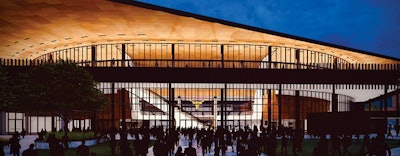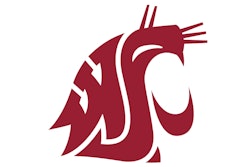
The University of Texas at Austin knew it wanted to build a new arena for its men's and women's basketball teams. The school just didn't want to pay for one.
That might sound like a ridiculous proposition, but here we are in 2021, and the Longhorns are on the verge of opening the Moody Center in 2022. The $338 million, 15,000-seat basketball and entertainment venue located at the heart of campus is the result of a public-private partnership six years in the making.
A relatively new trend in collegiate sports facility design, P3s are trending in popularity with cash-strapped schools that still want to enhance their campuses with state-of-the-art athletics venues. Here's a look at how Texas managed to have a third party build the school's brand new world class arena, while also giving its beloved home city a much-needed entertainment venue.
Baby steps
"The UT president at the time said, 'All we want to do is donate the land and infrastructure, and then we want to look for someone else to build it for us, and then lease it back,' " explains Todd Runkle, principal and managing director at Gensler Austin, which created the conceptual design for the Moody Center.
The initial siting of the project and the design work were part of an extensive planning process, as UT sought to have all its ducks in a row before courting third-party developers.
"We went so far as to not only conceptually design the architecture but also the infrastructure," Runkle says. "We were able to figure out what utilities they would need so that they would know their expenditures for the infrastructure, as well as the land value. What was their best option? What could they then offer back to the developer that would make money for them, so it would be a good partnership for both the university as well as the developer?"
Gensler ended up looking at 12 sites around Austin, eventually settling on a plot of land near DKR Texas Memorial Stadium, as the school had prioritized finding a site that would engage the campus student community.
"In the city of Austin there are site limitations, and we had to move one major road to get the arena to fit," Runkle says, noting that this unlocked another seven acres for potential development for the university. "It was really not only for the arena, but it was also a long-term play both for academics and potential development of this land adjacent to not only the Moody Center, but also the football stadium, where they could potentially create something really special in the long term."
Once an initial design was approved, Gensler helped facilitate proposals from four developers, with Oak View Group eventually landing the project.
Says Runkle, "We brought these four developers on board and asked them, 'What would you want in the facility that would make sense and make it interesting for you to invest and partner with the university?' "
 CAPTION GOES HERE
CAPTION GOES HERE
Going all in
For Oak View Group, the Moody Center meant a chance to bolster the City of Austin's already robust music scene with a world-class music venue, while also ensuring that the venue is managed at a profit.
"The value proposition is always, 'Help us get a shovel in the ground, help us get the infrastructure and the utilities and those hardwired systems, but then let us go drive net new taxes, let us drive the job growth, and let us take that burden off of you," says Francesca Bodie, OVG board member and the firm's president of business development. "For us, we sit back and say, 'You guys go focus on what you're best at, and let us take the responsibility and onus on this piece,' and I think that's a conversation that a lot of folks are willing to have."
Bodie says OVG's decision to take on a project in Austin has only been reinforced by the city's recent economic boom. Over the past few years, Austin has attracted a number of major companies to relocate their headquarters there in light of the challenges presented by the COVID-19 pandemic.
"We look a little bit smarter than probably we should because of how much Austin has grown in the last three years," Bodie says. "But when we started this process back in 2018, it was really identifying a market that was really attracting a lot of music. Austin City Limits has had one of the most successful runs as a music festival and being a destination in October. Could we figure out a way in this city to get a new venue that would equally support the men's and women's basketball programs and the collegiate activation, as well as be a place for music?"
That's exactly the hope for the Moody Center when it opens next year, and OVG will take the reins when it comes to the day-to-day operations of the venue to ensure it remains profitable.
"The fundamental principle that makes a P3 work for us is that the onus of the financial responsibility sits with us," says Bodie. "So, all the private debt, all of the private equity is our responsibility, as well as the operational risk — which can be really cumbersome and burdensome."
 CAPTION GOES HERE
CAPTION GOES HERE
Planning is key
Runkle stresses that UT's planning process was key to what he sees as a successful partnership between the university and Oak View Group, and Bodie agrees with that assessment.
"The university had done a significant amount of work behind the scenes around their process, and how they would get it approved," Bodie says. "Athletic director Chris Del Conte was really empowered to make those decisions to expedite and further along our negotiations, and so when we proposed it, we said we would build the arena at our cost, there would be no recourse back to the university."
Having the university's wants and needs presented in the form of the conceptual designs was a huge lift already completed once Oak View Group signed on.
"They weren't starting over," says Runkle. "The vision was set. And, certainly, OVG could alter it and improve it, but it was really kind of driven from the university's conceptual design and program. At least from my point of view, it's been an amazing partnership."
Balancing the needs of a major entertainment venue — the only music venue of its size in the city — and a properly scaled basketball arena required some workarounds. Oak View was seeking a lot of seats to generate revenue, while the Longhorns wanted to ensure they could host opponents in a loud and intimate environment.
"When OVG came in, they were really focused on increasing the seat count," Runkle explains. "For entertainment, they really wanted to drive the seat count up to 18,500, and so one of the tricks that we did on the upper concourse were these automatic garage doors. For basketball, you can close the upper concourse with these doors so it becomes a 13,500-seat venue for sports. But then for entertainment, they open up the upper concourse and it increases the capacity by almost 6,000 seats."
And then there were the differing amenities needed for the different-use cases. For example, the number of food and beverage vendors needed to be increased for large concerts that take advantage of the whole arena.
"We have probably four, if not five, significant F&B clubs in the Moody Center that will really cater to a much higher-end clientele," Runkle says. "I think having a number of clubs, having the level of concourse spaces, bars and so on, made it much more interesting to OVG in that they could host events and probably become one of the premiere venues in Texas."
Lastly, a balance had to be reached in terms of branding. While UT definitely wanted the venue to be identifiable as a home to the Longhorn faithful, Oak View Group required a more modest approach, with space for major sponsors to splash their logos in front of fans.
"Oak View Group didn't want it overly UT," Runkle says. "I would have to say, they've worked, in my opinion, really well to brand the areas that were UT-specific. For example, they have some dedicated locker rooms and areas that obviously will be heavily branded. But largely in the concourses, and other areas, they're more branded to the partners that have bought the clubs. Dell bought one of the clubs. Hulu has one of the stages, so there's a variety of partners that have branded throughout. But, certainly, the main plaza is branded with University of Texas, and then in their specific areas, as well, such as locker rooms and those kinds of team spaces."
Consider the possibilities
While the P3 model may not be the right model for every project, it shouldn't be ignored.
"Any school that has given any thought to this type of development on campus is worth talking to," says Bodie. "I think one of the benefits, and one of the reasons we've grown so much as a company, is because we have no set deal structure in place. We want to be collaborative, and I think that those who approach it as 'one shape will fit all universities' are going to end up being very disappointed, because every school is different in terms of the challenges and how it needs to manage things internally."
At Gensler, Runkle says his firm is already seeing more interest in these types of projects and has had a number of schools visit the Moody Center to better understand the process.
"We've been contacted for two other P3s with collegiate universities," he says. "The sports world and collegiate world have been relatively slow over the past year due to the pandemic. But we certainly have seen an uptick of interest, and several universities have come to visit and to look at the project and to meet with us and other developers to understand the process and so on. I really think that this model will be hugely successful."
The Right FitThere are a few key things to consider that are integral to ensuring a successful public-private partnership. One of the most important factors is ensuring that the venue is the right size and cost to fit the public institution's needs, while also turning a profit for the private entity. Don Barnum, architect at DLR Group, believes P3s will continue to grow in popularity and are always worth considering, but he also asserts that the project has to fit the model. "What I'm afraid of is that people think that this is somehow a panacea that will solve every problem that they have. 'Well, I want to do this project, let's just do a P3, and it doesn't cost a thing,' " says Barnum. But a P3 is no silver bullet, Barnum says, noting that facility size and cost are factors critical to the success of the project. Go too small and there aren't enough seats for the private entity to make a profit. Go too large and the upfront cost might be unattractive. "Any time there is a partnership with the private sector, there's actually more demand on the facility to turn a profit and to return revenue on the investment," says Barnum. "The private sector isn't philanthropic, and typically an investor would demand more profit than the institution itself might need." Nevertheless, Barnum says every feasibility study should include this type of model. "Biggest benefit for the user is that they don't have to have the capital investment, and that user could be a city or a university," says Barnum. "Depending on the terms of the agreement, they may not even have any operational kinds of expenses either. Why wouldn't you consider the way that you could deliver it with your own funds versus what the private sector could offer through private financing?" |
This article originally appeared in the September 2021 issue of Athletic Business with the title "Public-Private Partnership Delivers Moody Center to University of Texas" Athletic Business is a free magazine for professionals in the athletic, fitness and recreation industry. Click here to subscribe.





































